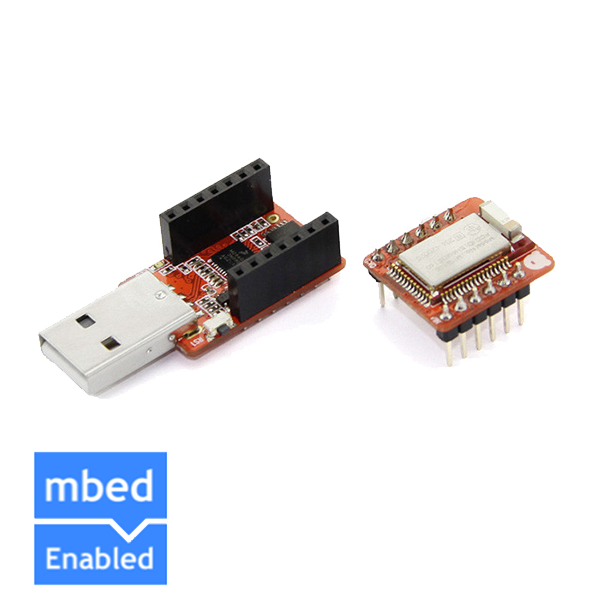We use cookies to make your experience better. To comply with the new e-Privacy directive, we need to ask for your consent to set the cookies. Learn more.

BLE Nano is the smallest Bluetooth Low Energy System-on-Chip (SoC) development board, only 18.5 x 21mm.
You could develop application using Nordic's SDK, mbed.org or our open source Arduino Library for nRF51822.
This Kit include a companion board, MK20 USB, which is used to load firmware into BLE Nano from a PC.
Features
- Smallest BLE development board, only 18.5mm x 21.0mm
- Nordic nRF51822 SoC supports both BLE Central and BLE Peripheral roles
- Ultra low power consumption
- Support voltage from 1.8V to 3.3V
- Software development using mbed.org, GCC, Keil or Arduino
- Lots of libraries and examples available
- Easy firmware deployment with our MK20 USB board or Over-the-Air download (available soon)
- Work with our free Android App and iOS App
Description
BLE Nano is the smallest Bluetooth 4.1 Low Energy (BLE) development board in the market. The core is Nordic nRF51822 (an ARM Cortex-M0 SoC plus BLE capability) running at 16MHz with ultra low power consumption.
Developing a Bluetooth Smart enabled 'appcessory' (accessory device + companion application) is easier than ever. You can quickly produce protypes and demos target for Internet of Things (IoT) and other interesting projects. BLE Nano could operate under 1.8V to 3.3V, therefore it works with a lot of electronic components.
Current supported BLE central devices:
iOS 7 or 8
- iPhone 4s
- iPhone 5/6 (all models)
- iPod touch 5
- iPad 3/4/mini/Air
Android 4.3 or above (4.4 recommended for stability) with Bluetooth 4.0 hardware support
- Nexus 4
- Nexus 5
- Nexus 7
- other compatible Android devices reported by our users
(please report any other Android devices supported)
Windows Phone 8.1
- Nokia Lumia 630
- (please report any other Windows Phone devices supported)
Windows 8.1 with built-in Bluetooth 4.0 or USB dongle
Mac OSX 10.9.2 with built-in Bluetooth 4.0 or USB dongle
Linux with BlueZ 5.1 with built-in Bluetooth 4.0 or USB dongle
Programming
There are three options to program your BLE Nano with MK20 USB Board.
Nordic nRF51822 BLE SDK
If you want the full power of nRF51822, you should use Nordic nRF51822 BLE SDK, we provide a product key for all registered users* of our BLE Nano to download the SDK.
We have prepared a guide "Firmware Development with nRF51822 SDK" to show you how to use the SDK with ARM GCC.
mbed's Bluetooth Low Energy API
The mbed platform, developed by ARM, provides free software libraries and online tools for professional rapid prototyping of products based on ARM microcontrollers. Their Bluetooth Low Energy Development Team has released the mbed BLE API together with 10+ samples.
Our "Getting Started with nRF51822" guide shows you how to start programming with mbed.
Arduino Library for nRF51822
We have developed an Arduino library for nRF51822 which will be open-sourced and publicly available in the future; it is still at pre-release stage but we invite all interested registered users* of our BLE Nano to access the pre-release library and sample sketches including BLE Controller, Beacon, Heart Rate Monitor etc. Please refer to our "Getting Started with nRF51822" guide for more details.
* You will find a product registration card inside the BLE Nano box with the instruction on how to register.
Power Supply
VIN

The BLE Nano can accept 3.3V to 13V from the VIN pin, voltage will be regulated to 3.3V via the onboard LDO as the nRF51822 chip operates at 3.3V. Thus, you can connect a rechargeable battery to it directly. Also, if you have another component to work with the BLE Nano, you can get 3.3V from the VDD as power supply to your component.
VDD

VDD can accept 1.8V to 3.3V only, if you have another MCU to work with the BLE Nano and that can supply 1.8V to 3.3V output, you should connect it to VDD of the BLE Nano. This would allow your BLE Nano to work components below 3.3V (e.g. 1.8V).
*Caution
- DO NOT supply power from both VIN and VDD, it will damage the BLE Nano
- DO NOT supply higher than 3.3V to VDD, it will damage the BLE Nano
- DO NOT supply higher than 13V to VIN, it will damage the BLE Nano
BLE Nano Pinout

The on-board LED is connected to Pin 19 (P0_19).
Pin 30 (P0_30) is used as a signal pin. If short switch S5 but leave switch S10 open, pin 30 will be GND (low); if short S10 but leave S5 open, pin 30 will be VDD (high). Developer can make appropriate decision in the firmware according to the state of pin 30; some Nordic's firmware detect this to decide which pins to be used as Serial (UART) pins.
Switches S1 to S4 and S6 to S9 are used to select which pins to be used as UART connections (RTS, RXD, TXD and CTS). By default they are wired to p8 to p11, most Nordic's firmware use this settings, for example their Packet Sniffer firmware. If you want to have more analog pins for your project, you could consider routing the serial interface to p0 to p3.
BLE Nano Specification
| Microcontroller | Nordic nRF51822 |
| CMSIS-DAP Chip | Freescale MK20 |
| Operating Voltage | 1.8V to 3.3V |
| Input Voltage | 1.8V-3.3V (VDD) 3.3V-13V (VIN) Caution: Use either one power source at a time, otherwise you will damage the board. |
| Clock Speed | 16MHz |
| Connectivity | Bluetooth 4.0 Low Energy Serial (TX/RX) I2C SPI |
| Flash Memory | 256KB |
| SRAM | 16KB |
| Dimensions | 18.5 x 21.0mm |
| I/O Pins | 11 |
MK20 USB Board

The MK20 (Freescale MK20DX128VFM5) USB board acts as a dongle, it accepts 5V from USB port and regulates to 3.3V via the onboard LDO which can be used to power BLE Nano. It appears on your computer as both a serial port and a removable mass storage disk. Please refer to the guide Getting Started with BLE Nano to learn how to deploy firmware using MK20 USB board.

Since the BLE Nano can work as low as 1.8V, we have designed the MK20 USB board to run at 1.8V as well, simple short the switch S, then the regulator will outputs 1.8V instead. This would allow your BLE Nano to work with 1.8V components.






Please login to comment.
Don't have an account?
Sign Up for free